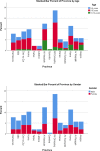Rates and trends of childhood acute lymphoblastic leukaemia: an epidemiology study
- PMID: 32317670
- PMCID: PMC7174306
- DOI: 10.1038/s41598-020-63528-0
Rates and trends of childhood acute lymphoblastic leukaemia: an epidemiology study
Abstract
Acute lymphoblastic leukaemia (ALL) is the most common childhood cancer and has a high survival rate when properly managed. Prognosis is correlated with many factors such as age, gender, white blood cell (WBC) count, CD10, French-American-British (FAB) classification, and many others. Many of these factors are included in this study as they play a major role in establishing the best treatment protocol. This study aims to demonstrate clinical and laboratory features of childhood ALL in Syria. They were treated at Children's University Hospital, the only working major cancer centre in Syria at the time of the study. Data of 203 patients who aged 0-14 years were obtained for this study. Most patients (48.8%) aged (5-9) years with a male predominance (60.9%). The major features for ALL included lymphadenopathy (82.9%), presenting with systemic symptoms (74.9%), T-ALL subclass (20.2%), L2 FAB classification (36.1%), low educational levels for fathers (53%) and mothers (56.2%), having a high risk (48.4%), and having a duration of symptoms before evaluation for more than 4 weeks (42.6%). Only three (1.5%) patients had normal full blood counts (FBC) and only one (0.5%) patient had an isolated high WBC count at time of presentation. Most patients had either abnormal platelet count (89.3%) or low haemoglobin level (88.8%) when presenting with only (2.0%) having normal levels for both. This suggests that having normal haemoglobin and platelet count can be used for quick screening in crisis time like in Syria for prioritising patients. Many prognostic factors were significantly different from medical literature which emphasises the importance of local studies in the developping countries. This study included a high prevalence of T-all, L2 FAB classification, high-risk and other variables which require further studies to evaluate the aetiology of these features, especially that treatment protocols may have a higher mortality in developing countries when not adjusted to local variables.
Conflict of interest statement
The authors declare no competing interests.
Figures
References
-
- Childhood Acute Lymphoblastic Leukemia Treatment (PDQ(R)): Health Professional Version, in PDQ Cancer Information Summaries. Updated on February 6, 2020: Bethesda (MD).
MeSH terms
Substances
LinkOut - more resources
Full Text Sources



